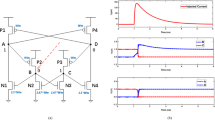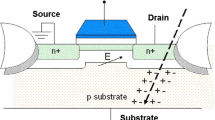Abstract
Dynamic logic families are commonly used in high speed applications, but they are susceptible to single event errors. This paper presents and evaluates three techniques of hardening dynamic logic—layout manipulation using charge sharing, addition of a feedback capacitor across the static inverter, and dual-rail domino logic with differential keepers. The layout-based design has better single event tolerance by sharing charge between NFET devices of the dynamic and static inverters; the design with a feedback capacitor makes the keeper more effective in recovering the hit node because of the increased propagation delay; the differential-keeper structure shows superior SET performance because the hit node could recover through the restoring path in the case of charge loss. These proposed designs along with the reference traditional keeper-based design were fabricated in a 130 nm technology node as shift register chains and then irradiated by heavy ion particles. Experimental results verified the mechanisms and effectiveness of these proposed designs.









Similar content being viewed by others
References
Asadi G, Tahoori M (2005) An accurate ser estimation method based on propagation probability. in Proceedings Design, Automation and Test in Europe, 1: 306–307
Atkinson N, Witulski A, Holman W, Ahlbin J, Bhuva B, Massengill L. Layout technique for single-event transient mitigation via pulse quenching. IEEE Trans Nucl Sci. 2011;58(3):885–90.
Calin T, Nicolaidis M, Velazco R. Upset hardened memory design for submicronCMOS technology. IEEE Trans Nucl Sci. 1996;43(6):2874–8.
Chang S-C, Cheng C-H, Jone W-B, Lee S-D, Wang J-S. Charge-sharing alleviation and detection for cmos domino circuits. IEEE Trans Comput Aided Des Integr Circ Syst. 2001;20(2):266–80.
Dodd P, Massengill L. Basic mechanisms and modeling of single-event upset in digital microelectronics. IEEE Trans Nucl Sci. 2003;50(3):583–602.
Erstad D (2010) Dual redundant dynamic logic. US Patent 7,679,403. [Online]. Available: https://www.google.com/patents/US7679403
Gronowski P, Bowhill W, Preston R, Gowan M, Allmon R. High-performance microprocessor design. IEEE J Solid-State Circ. 1998;33(5):676–86.
Holt CF. Analysis of single event transients in dynamic logic circuitry. Master’s thesis: Vanderbilt University; 2008.
Kumar J, Tahoori M (2005) A low power soft error suppression technique for dynamic logic. Proc IEEE International Symposium on Defect and Fault Tolerance, pp 454–462
Messenger G. Collection of charge on junction nodes from ion tracks. IEEE Trans Nucl Sci. 1982;29(6):2024–31.
Naffziger S, Colon-Bonet G, Fischer T, Riedlinger R, Sullivan T, Grutkowski T. The implementation of the Itanium 2 micro- processor. IEEE J Solid-State Circ. 2002;37(11):1448–60.
Nicolaidis M. Design for soft error mitigation. Device Mater IEEE Trans Reliab. 2005;5(3):405–18.
Nieuwland A, Jasarevic S, Jerin G (2006) Combinational logic soft error analysis and protection. Proc 12th IEEE International On-Line Testing Symposium, 2006, pp. 1–6
Normand E. Single-event effects in avionics. IEEE Trans Nucl Sci. 1996;43(2):461–74.
Oliveira R, Jagirdar A, Chakraborty TJ (2007) A TMR Scheme for SEU Mitigation in Scan Flip-Flops. Quality Electronic Design, 2007. ISQED '07. 8th International Symposium on, pp 905, 910
She X, Li N, Erstad D. SET tolerant dynamic logic. IEEE Trans Nucl Sci. 2012;59(2):434–8.
Shivakumar P, Kistler M, Keckler S, Burger D, Alvisi L (2002) Modeling the effect of technology trends on the soft error rate of combinational logic. In Dependable Systems and Networks. DSN 2002. Proc International Conference on Dependable Systems and Networks, p 389–398
SIA (2001) The international technology roadmap for semiconductors. [Online]. Available: http://www.itrs.net/Links/2001ITRS/Design.pdf
Wang C-C, Huang C-C, Lee C-L, Cheng T-W. A low power high-speed 8-bit pipelining CLA design using dual-threshold voltage domino logic. IEEE Trans Very Large Scale Integr (VLSI) Syst. 2008;16(5):594–8.
Warnock J, Chan Y-H, Carey S, Wen H, Meaney P, Gerwig G, et al. Circuit and physical design implementation of the microprocessor chip for the zenterprise system. IEEE J Solid-State Circ. 2012;47(1):151–63.
Acknowledgments
The University of Saskatchewan appreciates the support from Natural Science and Engineering Research Council of Canada, and CMC Microsystems. This work was supported in part by the Fundamental Research Funds for the Central Universities (26120132013B08714).
Author information
Authors and Affiliations
Corresponding author
Additional information
Responsible Editor: P. Girard
Rights and permissions
About this article
Cite this article
Wang, HB., Li, ML., Chen, L. et al. Single Event Resilient Dynamic Logic Designs. J Electron Test 30, 751–761 (2014). https://doi.org/10.1007/s10836-014-5492-2
Received:
Accepted:
Published:
Issue Date:
DOI: https://doi.org/10.1007/s10836-014-5492-2




